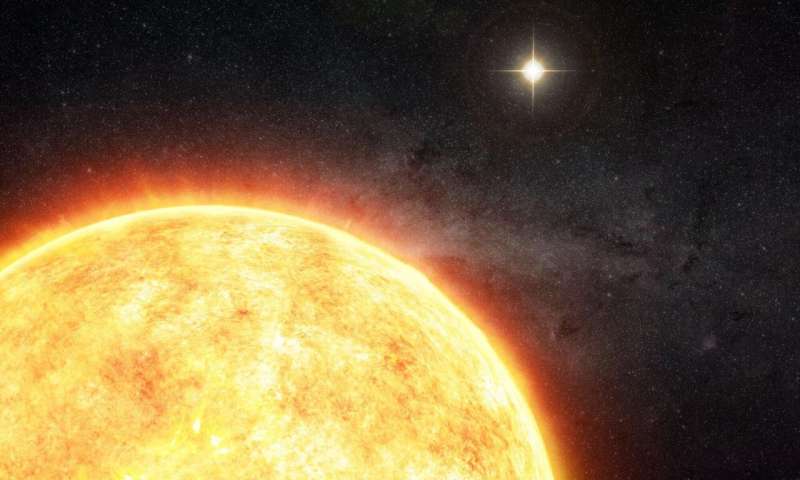This article has been reviewed according to Science X's editorial process and policies. Editors have highlighted the following attributes while ensuring the content's credibility:
fact-checked
trusted source
proofread
The improbable origins of life on Earth

We do not yet know how, where, or why life first appeared on our planet. Part of the difficulty is that "life" has no strict, universally agreed-upon definition.
Normally this is not an issue, as the vast majority of life is most definitely alive, and only biologists interested in the extreme edges—viruses, prions, and the like—need to worry about precise classifications. But to study the origins of life we must, by necessity, examine a process that takes non-living matter and fundamentally changes it. Presumably this process happened in stages, with fits and starts along the way, and so the line between uncoordinated chemical reactions and the beginnings of vibrancy must be blurred.
It's helpful here to present at least a simple working definition of life, not to rewrite the biology textbooks, but so that at least we can properly frame the discussion of life's origins. And for those purposes a simple statement will suffice: Life is that which is subject to Darwinian evolution. That is, life experiences natural selection, that unceasing pressure that chooses traits and characteristics to pass down to a new generation through the simple virtue of their survivability. If the trait contributes in some way, even circuitously, to the survivability of an organism and its ability to reproduce, it persists. All else is discarded (or, at best, gets carried unceremoniously along for the ride).
Earth is the only known place in the solar system, in the galaxy, in the entire universe where Darwinian evolution takes place.
To succeed at evolution and separate itself from mere chemical reactions, life must do three things. First, it must somehow store information, such as the encoding for various processes, traits, and characteristics. This way the successful traits can pass from one generation to another.
Second, life must self-replicate. It must be able to make reasonably accurate copies of its own molecular structure, so that the information contained within itself has the chance to become a new generation, changed and altered based on its survivability.
Lastly, life must catalyze reactions. It must affect its own environment, whether for movement, or to acquire or store energy, or grow new structures, or all the many wonderful activities that life does on a daily basis.
By interacting with its environment, making copies of itself, and storing information (like how to interact with the environment and make copies of itself), life can evolve, growing in complexity and specialization over geologic time, from humble molecules to conscious minds capable of peering into its own shrouded origins.
In the modern era, with billions of years of practice behind it, life on Earth has evolved a dizzying array of chemical and molecular machines to propagate itself—a menagerie so complex and interconnected that we do not yet fully understand it. But a basic picture has emerged. Put exceedingly simply (for I would hate for you to mistake me for a biologist), life accomplishes these tasks with a triad of molecular tools.
One is the DNA, which through its genetic code stores information using combinations of just four molecules: Adenine, guanine, cytosine, and thymine. The raw ability of DNA to store massive amounts of information is nothing short of a miracle; our own digital system of 1's and 0's (invented because it's much simpler to tell if a circuit is on or off than some stage in-between) is the closest comparison we can make to DNA's information density. Natural languages don't even earn a place on the chart.
The second component is RNA, which is intriguingly similar to DNA but with two subtle, but significant, differences: RNA swaps out thymine for uracil in its codebase, and contains the sugar ribose, which is one oxygen atom short of the deoxyribose of DNA. RNA also stores information but, again speaking only in generalities, has the main job of reading the chemical instructions stored in the DNA and using that to manufacture the last member of the triad, proteins.
"Proteins" is a generic catch-all term for the almost uncountable varieties of molecular machines that do stuff: They snip apart molecules, bind them back together, manufacture new ones, hold structures together, become structures themselves, move important molecules from one place to another, transform energy from one form to another, and so on.
Proteins have one additional function: They perform the job of unraveling DNA and making copies of it. Thus the triad completes all the functions of life: DNA stores information, RNA uses that information to manufacture proteins, and the proteins interact with the environment and perform the self-replication of DNA. This cycle allows living organisms to experience the gift of evolution.
And this cycle is, as I said, gloriously complex and obviously the result of billions of years of fine-tuning and refinement. The interconnected nature of DNA, RNA, and proteins means that it could not have sprung up ab initio from the primordial ooze, because if only one component is missing then the whole system falls apart—a three-legged table with one missing cannot stand.
Provided by Universe Today





















